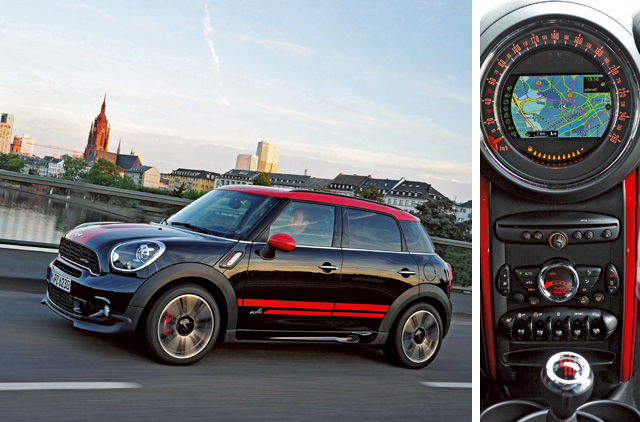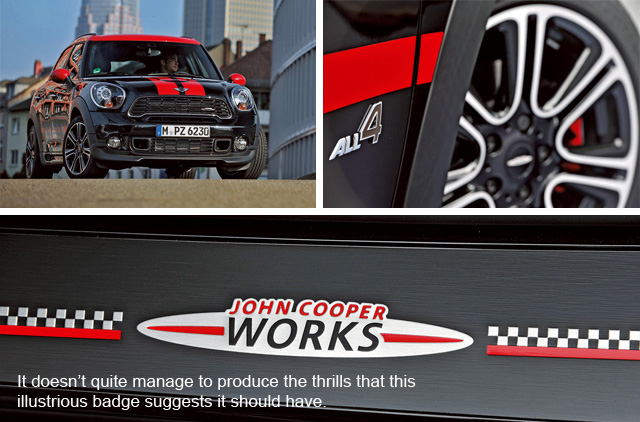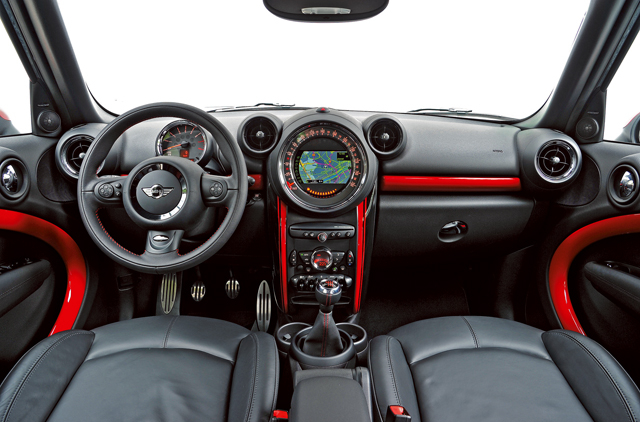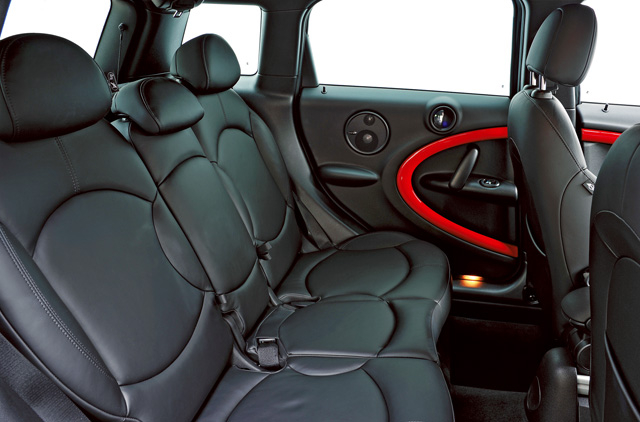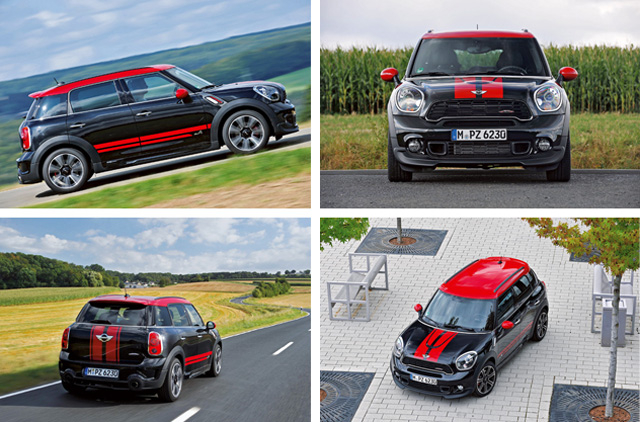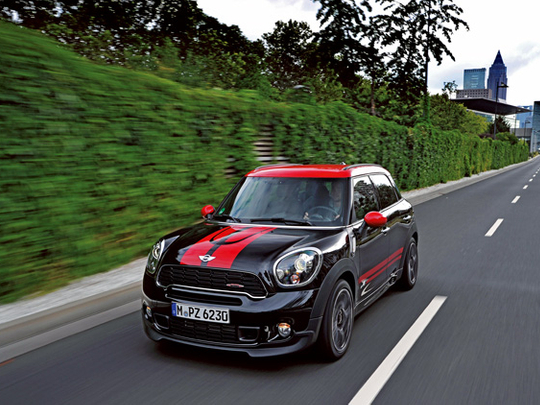
Pop into your local Mini dealership for a look around and you’ll be blown away by the vast array of models to choose from. Not only does the company do customisation like no other carmaker, but its core line-up now consists of seven different body styles (including the imminent Mini Paceman) and all are offered with each of the Cooper engine options. Die-hard fans of the pre-BMW Mini may not like it, but this is a brand still on the up and there’s much more to come if we’re to believe the rumours.
Looking at it logically it should be no surprise that Mini expanded the high-performance John Cooper Works portfolio to include the Countryman. Leaving aside the fire-spitting World Rally Car version that shreds gravel, tarmac and snow around the globe, you can already buy a JCW Hatch, Coupé, Cabrio, Clubman and Roadster — and you can bet your last dirham that a John Cooper Works Paceman is in the pipeline (itself a coupé interpretation of the Countryman).
Yet there’s something curious about the concept of a John Cooper Works Countryman. In brief, Mini created the Countryman to appeal to fans of the brand who needed a lot more space. Are we to conclude then that the JCW version is for previous owners of say a JCW Hatch who now have a baby on the way? After all, there are few other crossovers available — anywhere in the world — that have such a sporting remit. High-end BMW X models and Range Rover Sport Supercharged aside perhaps.
There’s no mistaking the new Mini either, is there? Especially not in the extrovert black and red colour scheme of the launch cars in Germany. Thankfully, other hues are available, though buyers must choose from a contrasting red, white or black for the roof and door mirrors. That possibly rules out an all-black stealth version, which is a shame. Those who dislike the shape of the Countryman won’t find much solace here. The styling add-ons and lower ride height do make it appear more like a five-door hatchback variant of the Mini than a crossover/SUV, though the black roof bars seem to visually heighten the car — something it certainly didn’t need.
Regardless, there’s plenty of bespoke detailing for the JCW fan to pore over. Round the back is a chunky, low bumper with a large-bore exhaust protruding from each side. Above that is the usual oversized Mini emblem found on the Countryman, along with a relatively modest roof spoiler. Beefier side sills have a fake air intake design feature beneath the rear doors and the standard 18in alloys fill the wheelarches convincingly.
Meanwhile the stubby nose is accentuated by a deeper bumper, big fog lamps and a bespoke John Cooper Works grille. The final flourishes are black backgrounds for the rather bug-like headlights. Pretty, this car is not. The red-black theme continues inside, which is fine for the most part, as it includes decent sports seats, a tactile leather steering wheel with red stitching, a bespoke gear lever top and darkened instruments. However, we didn’t like the red and black shiny plastic trim inserts.
At least the John Cooper Works version retains all the practicality of a regular Countryman. The boot swallows 350 litres of luggage and the rear seats (choose from a two- or three-seat layout) tilt, slide or fold out of the way. There are plenty of little cubbyholes in which to put your phone, car park tickets, etc too, and we especially like the new shiny electric window buttons — mounted on the doors as opposed to the centre console of old. Mini brought along a 1968 rally-prepared Mini to the launch of the JCW Countryman and the size difference is verging on comical — it really looks as if the old car could park in the boot of the new.
As with any Mini there’s loads of seat and wheel adjustment, though refugees from the hatchback will miss that ‘sitting on the ground’ feel of sportiness. Conversely, some will prefer the relatively elevated position, as it does offer a better view of the road ahead. And at the speeds this car is capable of, that’s a useful thing. The Countryman gets its own development of Mini’s tried-and-tested twin-scroll turbocharged 1.6-litre engine. It features variable valve timing based on BMW’s Valvetronic system and has the highest power and torque output of all the John Cooper Works family.
Mini quotes maximum power as 218bhp at 6,000rpm (identical to the limited edition GP Hatch incidentally), but it’s the torque figures that set this car apart. The nominal maximum value produced is 280Nm, though that’s available under all conditions from as little as 1,900rpm all the way around to 5,000rpm. However, there’s an overboost facility, where the engine’s computer can allow up to 300Nm to be delivered for short bursts.
We’re not quite sure how short these are, as Mini says it’s accessible between 2,100 and 4,500rpm, but we can confirm that the Countryman feels especially quick in the mid-range and it can really pile on the speed. A clear illustration of this was our time on the German autobahn. The speed limit varied from 100- to 130kph regularly with several long sections completely derestricted and lightly trafficked.
We felt no need to change gear throughout, and the car pulls strongly in sixth from 100kph up to about 200kph — by which time presumably the bluff aerodynamics are slowing the rate of acceleration. Find a long enough straight and it’ll theoretically top 225kph. The in-gear thrust is the Countryman’s strength, so don’t be too disappointedby the relatively tardy 0-100kph time of seven seconds dead.
There’s a big ‘but’ coming and that’s to do with how the Countryman drives. No matter how much you do to the chassis it’s never going to feel as agile or dynamic as the Mini hatch. Along with a 10mm lower ride height (of great benefit to the centre of gravity), the springs and dampers are firmer and the anti-roll bars stiffer. The net effect is a Countryman that’s more tied down than any other, but still a Countryman. Despite the changes there’s much more body movement than you’ll find in other Minis and it takes a little familiarisation with this before you realise you can lean on it quite hard. Grip levels are high, as are cornering speeds once you’re used to the car.
It’s worth pressing the Sport button to access the sharper throttle response and firmer steering, as this helps the Countryman come alive. It’s very stable under braking, while hard acceleration out of tight corners is fuss free thanks to the standard four-wheel drive system. An electronically controlled clutch distributes power between the front and rear wheels as needs be, though in truth, most of the time it drives like a front-wheel drive car with loads of grip. That’s great for safety and cross-country pace no matter what the road conditions, but it loses some of the manic nature of the front-drive hatches, which some might say have too much power at their disposal.
Mini has sensibly retained one aspect of the fast hatchbacks in this model and that’s an exhaust system that pops, bangs and crackles on the overrun — more so in Sport mode. Old fast cars used to do this, not because it’s fun, but because they didn’t have sophisticated computers metering out every drop of fuel. Nowadays they do, so there’s no excuse for such a thing to happen by mistake — and it hasn’t. Mini’s engineers purposely developed this attribute to add character — and it works. Put simply, the spark timing is retarded so much that a small amount of unburned fuel escapes the combustion chamber and then ignites in the hot exhaust.
We’re told it really is tiny volumes of fuel so shouldn’t affect fuel consumption by any significant amount. On an interesting piece of road it’s highly addictive to lift off the throttle just to hear a series of bangs in the exhaust, though at times it sounds just like deep bass coming from the trunk of the car.
The John Cooper Works Countryman is still fun, make no mistake, but it’s not as engaging as the regular Cooper S hatch, never mind the bonkers JCW version. In return it is a little more comfortable and clearly a lot more practical.
Buyers who love the mad Mini image and hanker after that, with a dose of hot hatch performance, in a more practical package, will love it. The rest of us have plenty more choice in the Mini line-up.


